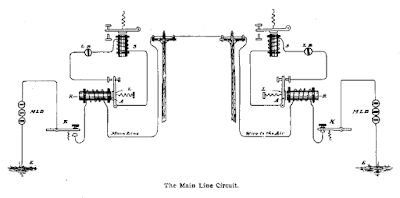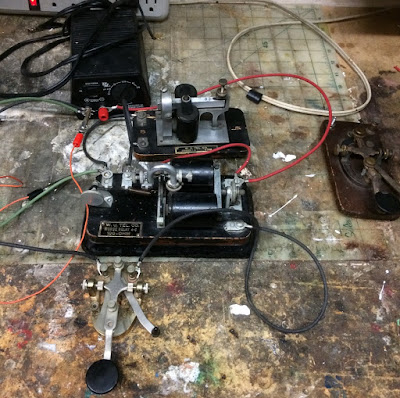Figuring Out The Wiring And Power
Old time telegraph lines ran as a single line using ground as a common connector. The voltage on this single wire could be as high as 100 volts. The high voltage allowed them to make up for the resistance in the cable and cover the long distances with a single piece of wire.The telegraph sounder at the station ran at much lower voltage, typically 1-6 volts. Sounders came in different resistance ratings (rated in ohms) to accommodate the different voltages and the proper sounder for a specific voltage can be computed using ohms law. (I found a good explanation in this article for folks who want more details.) To protect the local sounder (and operator) from the high voltage line, a relay was used in the station to isolate it from the main line. Here is an illustration of a typical circuit.
Here is an example sounder and relay that I picked up at the beginning of the project to test this out. It's a 4 ohm sounder and a 100 ohm relay.
First Decision: Use Relays?
I ruled out pretty early on any chance of using high voltages with this project. The station was going to be operated by kids. Also, the telegraph run was unlikely to be more than 100 feet so low voltage would be fine. This meant I could elminate the need for the relay.
Second Decision: Operating voltage?
After testing at a few different voltages, I decided to operate on nine volts. This was a bit high for my 4 ohm sounders, but it made a nice loud click that I felt the kids would be able to hear better. Sure, the coils might get warm if used heavily, but I expected the duty cycle required from 8th graders would not be too bad.
Third Decision: Simplex Or Duplex?
If I wanted to be authentic, I suppose I'd be running one wire and pounding in ground cables at the site. Though, since this was a short run, I decided to run the telegraph with two wires (duplex). This would take double the wire, but would eliminate the need to drive a grounding rod at the re-enactment site.
Building the Telegraph Stations
Once I had the design figured out, it was time to build the actual telegraph stations. I wanted to the telegraph to be as authentic looking as possible, but also be able to be set up and run by 8th grade re-enactors. I didn't want to spend a lot of money on 19th century equipment so I targeted purchasing equipment from around 1900. I found some nice old sounders and used keys that I had collected on my own.I mounted the pairs of keys and sounders on oak boards that I coated with Shellac. Each board also got a print out of the morse code for the re-enactors to reference in case they forgot a letter at the event.
For the 9V power supplies, I put two 9V batteries in parallel on a piece of oak. This could be tucked under the table to hide the fact that we were using modern batteries.
For the cable hookups, I actually tried two different designs. One design used three connectors. I stamped the wood with the hookup.
G = Ground
L = Line
P = Plus side of battery
Though, this requires the person hooking up the wires to understand that one of the wires coming on the telegraph is a "ground" and also the negative on the battery supply is a ground. To simplify the hookup, I also made some with two hookup locations. One for the battery, the other for the two telegraph lines. This also makes it more transparent and intuitive to see that all the sounders are hooked in parallel.
Once I had the stations built, It was time to test them out. This test is using 9V from the battery supplies.
Training The Learners
The telegraph was going to need to be operated by 8th grade students. They were all going to need to learn Morse Code and be able to copy/send it in the field. I put the code on all the stations, but it was going to require practice. We set up a code key in the classroom and got the kids practicing. A few of them talked about it in this video. Credit for the video goes to SCVTV.com.Deploying In The Field
With all the testing we did ahead of time, things went well the day of the event. Our telegraph was covered by multiple local news stations!- Santa Clarita TV (SCTV) - This video did some great overviews with the learners and also got some great coverage of the telegraph.
- KHTS Radio (AM1220/ FM 98.1) - Great closeups of the telegraph in action! Shows our fake galvanic battery that was supposed to appear as though it was powering the telegraph.
- Santa Clarita Valley Signal - Although they didn't cover the telegraph, they did cover some great highlights of the event.
- SCVi School Web Site - They announced the event, but no photos. They did post some great photos on Facebook which included multiple photos of the telegraph!
.
My favorite was the one of my daughter operating the telegraph. She did a great job!
My brother also recorded a great video of the overall event.
My brother also recorded a great video of the overall event.
Hopefully, we can find some more events were we can bring this and demonstrate it. Maybe we can find some other re-enactments in Southern California Until then at least we'll be able to break it out once a year for the school.















No comments:
Post a Comment
If you would like to reach out to the author directly, please email mschnitt@gmail.com